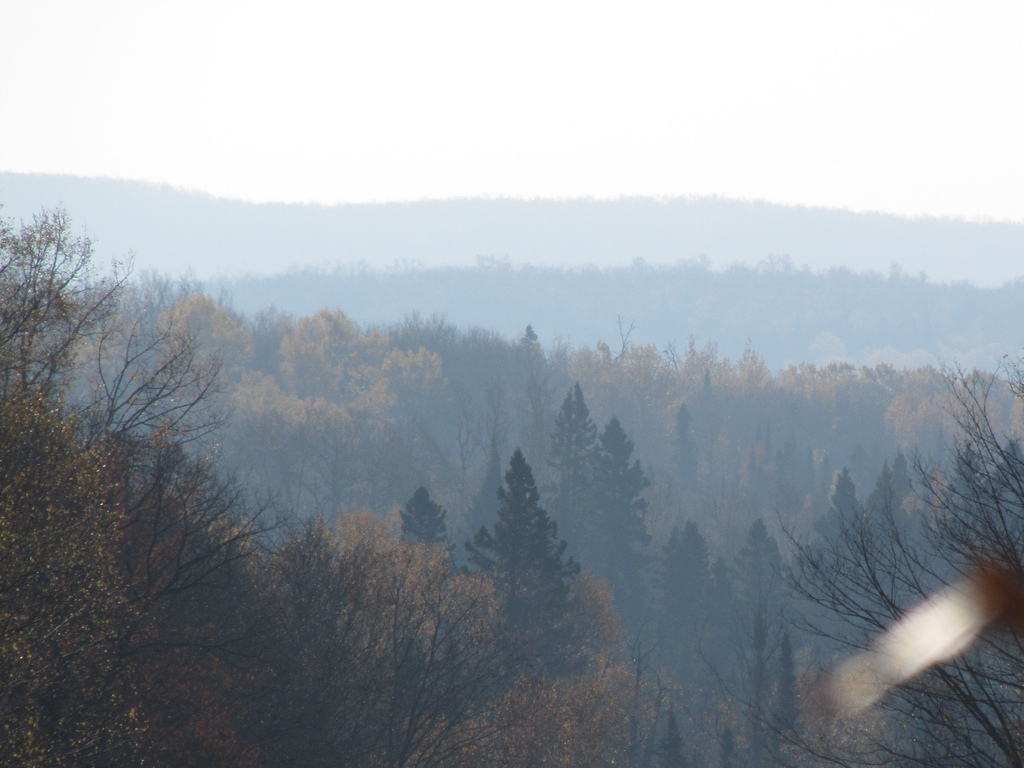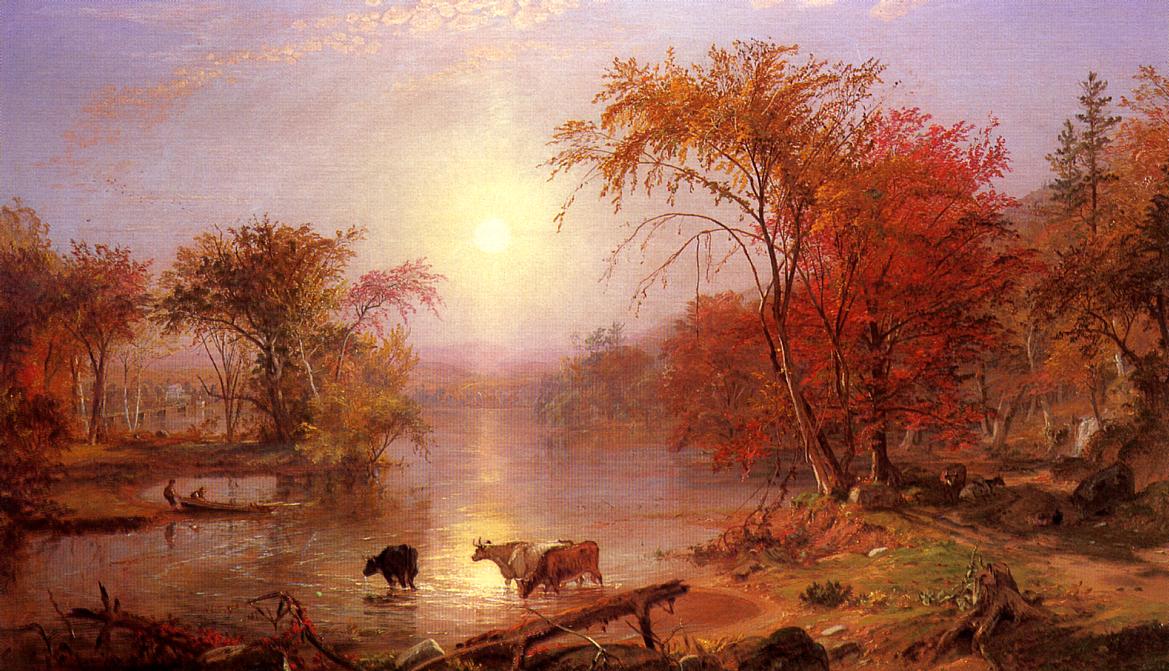A thick, smoky haze, often observed by early American writers, may have been the result of a weather phenomenon that no longer occurs.
Oct. 19. P. M. — To Pine Hill for chestnuts.
It is a very pleasant afternoon, quite still and cloudless, with a thick haze concealing the distant hills. Does not this haze mark the Indian summer?-Henry David Thoreau, Journal, 1855
In present-day usage, “Indian summer” often rather loosely refers to any spell of pleasant, warm weather that occurs after the leaves have begun to turn and the real summer has ended. Among early American writers, however, Indian summer was marked, rather specifically, by one sign — a smoky haze that lingered in the atmosphere and was especially pronounced on warm, calm days after the first frost of the season.
The etymology of the term is unknown, and theories as to its origin proliferate; most of these (at times somewhat pejoratively) seeking to ground the season in some American Indian religious belief or seasonal practice — hunting, agriculture, war, and so on. But by the late eighteenth century its meteorological connotation had become well established, with French-American writer J. Hector St. John de Crèvecœur providing an early reference in a 1778 letter from German Flatts, New York: “sometimes the rain is followed by an interval of calm and warmth which is called the Indian summer; its characteristics are a tranquil atmosphere and general smokiness … it arrives about the middle of November.” The event was illustrated not only in prose but landscape painting as well — eponymously by Hudson River School painters such as Albert Bierstadt in 1861, Sanford Robinson Gifford in 1862, and Jasper Francis Cropsey in 1866. Significantly, accounts seem to portray a uniquely American phenomenon, specific to New England and the Midwest (and particularly remarkable to migrants from Europe).
From de Crèvecœur to Cropsey, late eighteenth- to mid nineteenth-century observers depict the hazy air of Indian summer with a frequency that makes us wonder if the occurrence they observed was, perhaps, much more pronounced then than it is today. By the 1830s, even as scientific inquiry into the matter waxed, the Indian summer itself may have been declining in prevalence, as commenters began to view the Indian summer as something of lingering anachronism. As Bela Hubbard suggests in 1877, “We look in vain for any recognition … in pages not more than half of a century old. [The Indian summer] seems to have departed from the land of the Puritans with the vanished forests, and doubtless these had much to do with its former prevalence.”
Lyman Foot, a U. S. Army doctor who had been stationed in Missouri and at Fort Brady in Michigan’s Upper Peninsula, responded in 1835 to an open inquiry from the American Journal of Science and Arts into the origins of the smoky haze. Foot, based on his own observations as well as “considerable pains” taken to consult with “the Chippeways, Menominees, Winnebagoes and others” offers an anthropogenic explanation: that a particularly warm period in the fall would provide an advantageous opportunity for these indigenous agriculturalists to clear annual grasses or crops killed by the first frost. Foot describes having observed a “peculiar redness of the sky” from as much as four hundred miles distant as “the fields, the swamps, the forests and the prairies are set on fire by Indians and hunters.” Echoing Hubbard, Foot observes “the appearance of the decline of Indian summer in the eastern states … the forests there are disappearing. What are left (Indians, there are none,) hunters dare not set fire.”
Natural explanations, however, persisted. Zaddock Thompson, in his 1842 The History of Vermont: Natural, Civil, and Statistical, suggests aerosols created by the “solvent power” of the atmosphere from decaying leaves. Meteorologist John Brockelsby elaborates in 1873:
The Indian summer, with its genial warmth and misty veil, occurs at that period of the year when the leaves of the forest are falling, and the vegetation that covers the surface of the earth is beginning to decay. In view of this fact, the author was led to think, some years ago, that the decomposition of the decaying vegetation, which Leibig terms a slow combustion, (eremacausis), might impart that peculiar haziness to the atmosphere which is seen during the Indian summer. This phenomenon was ascribed to the same cause by another observer, Dr. E. B. Haskens, of Clarksville, Tenn., who also suggests, that the Indian-summer haze consists of carbonaceous matter or smoke produced by the oxidation of the lifeless vegetation.
Although Thompson and Brockelsby may have been on to something — hydrocarbons produced by decaying leaves do indeed produce hazy aerosols (Peter J. Marchand, Autumn: A Season of Change, 2000) — other times of the year have their own haze-producing factors, too: deciduous trees produce isoprene and conifers produce turpene; the latter (in addition to providing the forest’s piney scent) is known to combine with other compounds to form a haze that enhances cloud formation and keeps the forest cool. But turpene and isoprene emissions in the Northeast correspond with temperature, rising sharply in July and reaching a plateau in August and September.
Perhaps another, far more serious problem with the trees-produce-haze hypothesis has to do with what William M. Denevan terms “The Pristine Myth” — A romanticist view, fueled by writers such as Thoreau and Henry Wadsworth Longfellow, of primeval forest filled with noble savages that is as ethnocentric as it is inaccurate. The clearing of land (frequently by fire) for agriculture by indigenous populations was widespread prior to Euro-American settlement and many parts of the Northeast now have greater forest cover than they did in the time of the Puritans.
Foot’s anthropogenic hypothesis seems the most plausible, even though his account remains anecdotal, as historical population estimates for American Indian groups are notoriously inaccurate and the extent of indigenous agricultural practices in general is not well-documented. Prairie fires, eremacausis, and terpenes may have all combined with other, yet-to-be determined factors to produce an Indian summer haze of a hue and thickness that can’t be seen today. I, for one, imagine on warm November days that distant treetops look just a little different than they do in the rest of the year — though that could just be burning leaves and smog.



